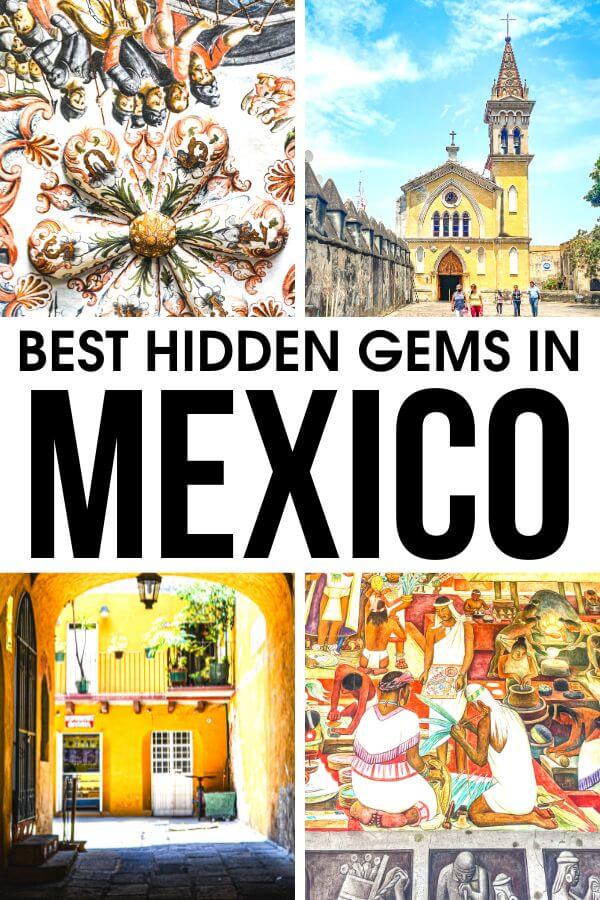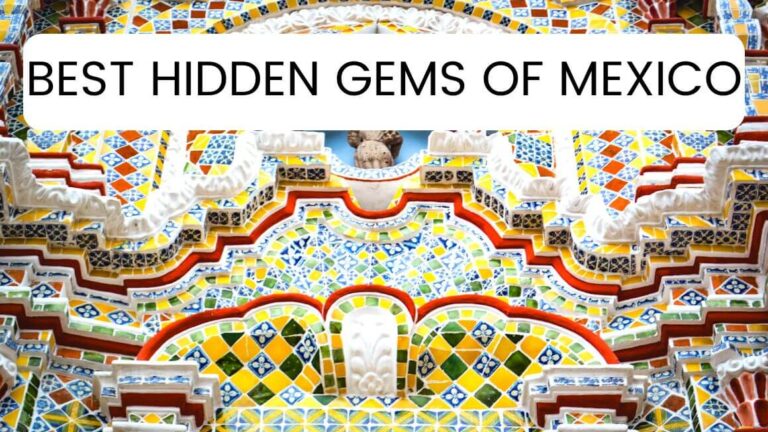Last Updated on January 21, 2024 by Soumya
The best hidden gems in Mexico are sometimes right under your nose! Take the case of Mexico City’s colorful murals, a unique Mexican attraction hidden in plain sight, still waiting to be discovered.
If you venture beyond the Mayans and the Aztecs, you’ll discover lesser-known Mexican civilizations like the Toltecs and the Totonacs.
Unique architectural styles such as Mexican Baroque and Churrigueresque await you in every corner while the lost cities of Palenque and El Tajin excite you with hidden treasures.
Those who wish to venture off the beaten path in Mexico will soon realize that the country’s hidden gems may be only a few minutes away from the most visited places.
For culture vultures like us, Mexico is full of secret gems. After several trips to Mexico and eons of research, here’s my pick of the Top 12 Offbeat Things to do in Mexico.
Please note: This post may contain affiliate links which means I may earn a commission if you make a purchase by clicking a link on this post. This will be at no additional cost to you. Affiliate links help me keep this website up and running. Thanks for your support!
Best Offbeat Experiences in Mexico – Top 12 Hidden Gems
Mexico City Mural Trail
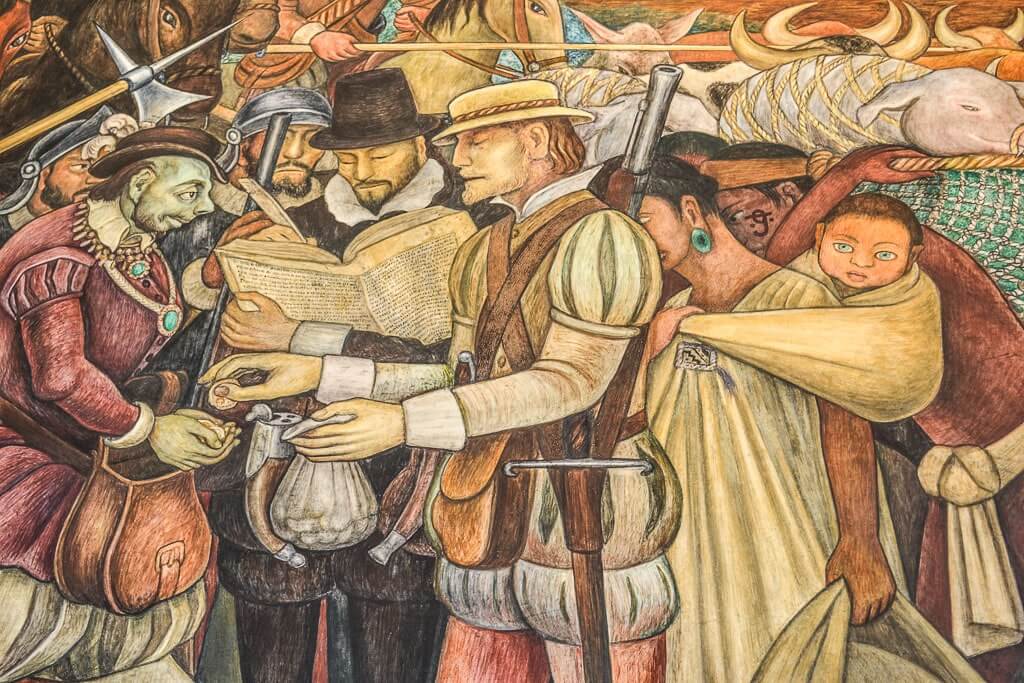
For those willing to venture off the beaten path in Mexico City, taking the mural trail is an interesting choice.
The murals of Mexico City display the city’s vibrant artistic spirit and historical legacy.
Mexico City was, after all, the birthplace of Mexican Muralism Movement. This movement was started by the government in the 1920s to give all Mexicans a common means to identify themselves with the vision of the new nation.
These colossal works of art are often overlooked by tourists who are drawn by the city’s more famous attractions, like its magnificent palaces and bustling markets.
Yet, the murals represent the soul of the city and narrate the country’s rich history, social transformations, and cultural revolutions.
Painted by renowned artists such as Diego Rivera and David Alfaro Siqueiros, these murals are more than mere decorations. They are powerful visual narratives that display Mexico’s struggles and triumphs.
Where to find the hidden murals of Mexico City?
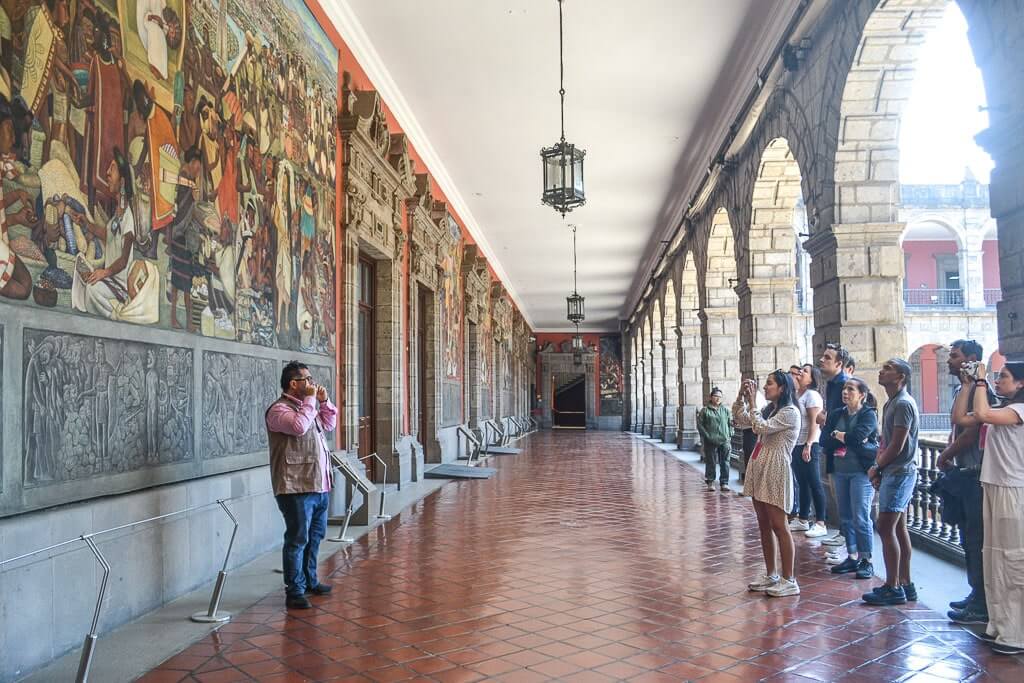
The murals are scattered throughout the city, hidden in plain sight on the walls of schools, public buildings, and even residential districts. Their unassuming locations often make them a surprise for those who stumble upon them.
My favorite places to check out murals in Mexico City include the National Palace, the Secretariat of Public Education, the Palace of Fine Arts, and the Chapultepec Castle. Good news – the first two sites are free to visit.
You’ll find lots of contemporary street art along Paseo de la Reforma and in the bohemian neighborhoods of Roma and Condesa. Simply walking around the Historic Center will also allow you to see fascinating murals.
If ancient murals interest you, do not forget to check out the mural trail at Teotihuacan Pyramids, only a day trip away from Mexico City.
✦ Pro Tip: The best way to see the murals of Mexico City is on a guided tour. I find this semi-private, mural art walking tour in downtown Mexico City very enlightening. In fact, this is one of my favorite tours in Mexico City.
Atlantean Warriors of Tula
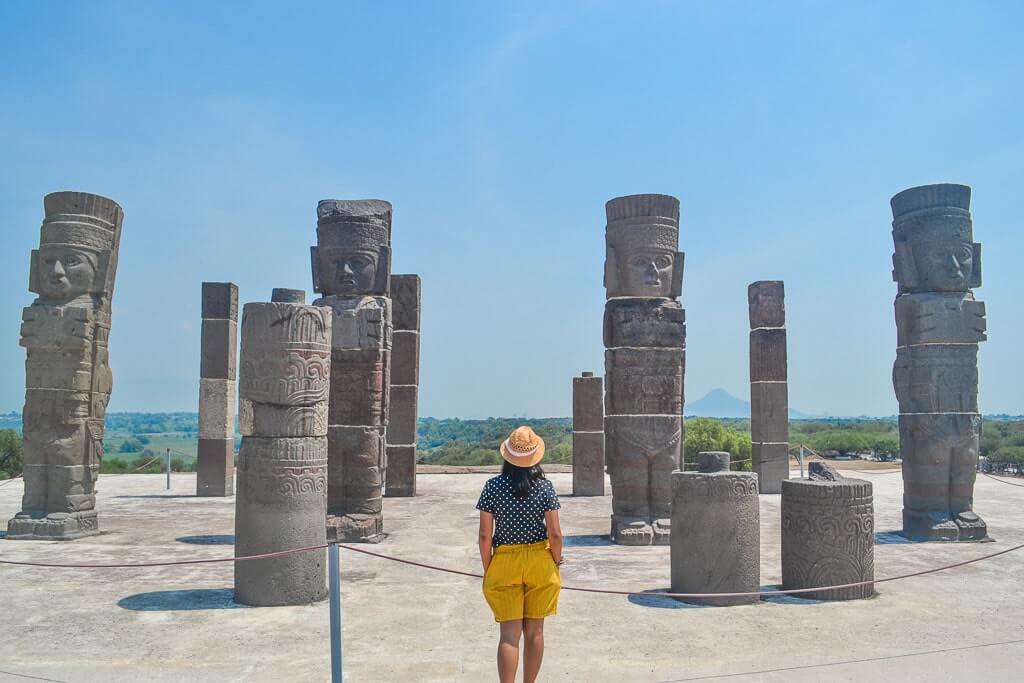
The Archeological Site of Tula was once the capital of the powerful Toltec Empire. Now, it is a lesser-known archeological site only visited by a handful of tourists annually.
Often overlooked in favor of more well-known Mexican pyramids like Chichen Itza or Teotihuacan, Tula offers a unique and offbeat glimpse into Mexico’s rich cultural past.
If you search for Tula online, the first pictures that come up are of gigantic Atlantean figures. They represent Toltec warriors bearing feathered headdresses, butterfly breastplates, and solar shields. Apparently, these statues held, over them, the roof of a Temple of Quetzalcoatl.
For centuries, the Atlantean figures atop Tula’s main pyramid have fascinated researchers and archeologists. How these giant monoliths were built or how they were transferred to the top of the pyramid – we have no clue!
There are theories that suggest that ancient Totonac people hand-carved these figures. How they did that 1000 years ago still remains a mystery.
Other highlights at Tula include smaller pyramids, ancient ballcourts, ruins of a palace, and a mysterious ceremonial ground referred to as “Burnt Palace.”
An intricately carved serpent wall known as the Coatepantli surrounds the Burnt Palace and adds to the aura of mystery at Tula.
✦ Pro Tip: Getting to Tula from Mexico City can be a little complicated. The most convenient way is to take this full-day guided tour of Tula from Mexico City.
Churrigueresque Architecture of Mexico
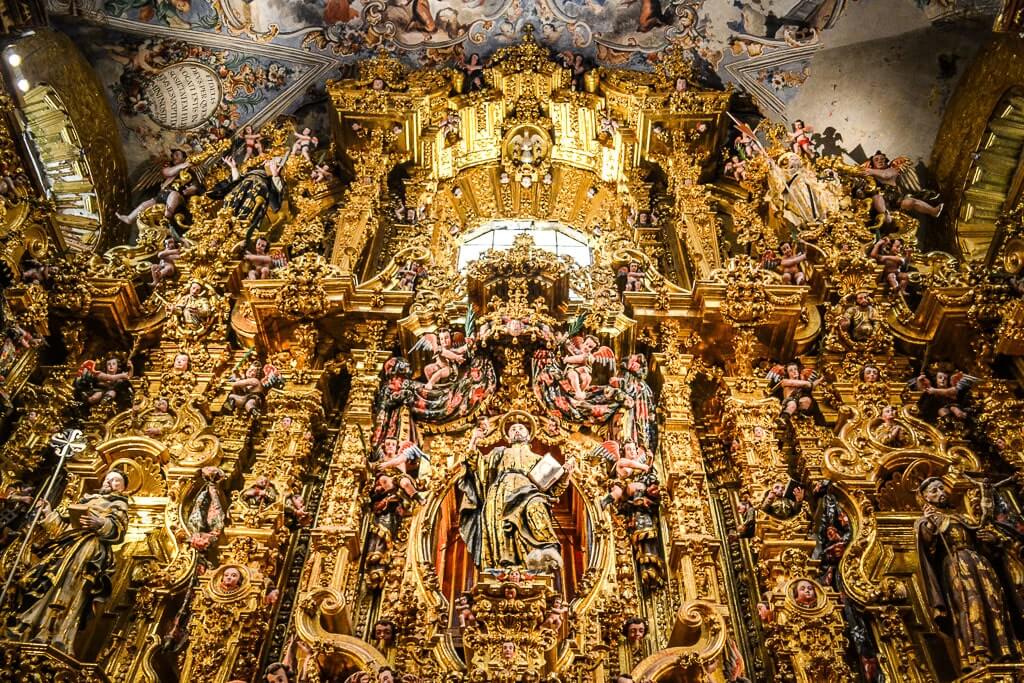
Culture enthusiasts will enjoy exploring Mexico’s lesser-known churches adorned with the exquisite Churrigueresque architecture.
This architectural style is a rare hidden gem often missed while touring the country’s famed pyramids and beaches. And like I told you, sometimes it is right under our nose!
The intricate Churrigueresque architectural style is named after the Spanish architect Jose Benito de Churriguera. It depicts a complex interplay of indigenous and colonial influences that have shaped Mexico’s architectural landscape.
The main features include elaborate detailing, excessive ornamentation, and a sense of movement that seems to defy the static nature of gold and stone.
The Church of San Francisco Javier in Tepotzotlan and the Santa Prisca Temple in Taxco are considered true masterpieces of Churrigueresque art.
If you’re looking for something more accessible, check out the Atlar of the Kings at the Metropolitan Cathedral in Mexico City.
Lavishly adorned Churrigueresque altars and intricately carved facades offer a visual treat to architecture enthusiasts. I was swept off my feet when I entered the church in Tepotzotlan. The resplendence that surrounded me was mind-boggling!
These architectural wonders, tucked away in the heart of Central Mexico, offer a rare glimpse into the grandeur and intricacies of Mexican churches.
✦ Pro Tip: On this highly-rated, full-day guided tour from Mexico City, you can see 2 hidden gems of Mexico on the same day – The Pyramids of Tula and the Church of San Francisco Javier in Tepotzotlan.
Sanctuary of Atotonilco – Mexico’s Sistine Chapel
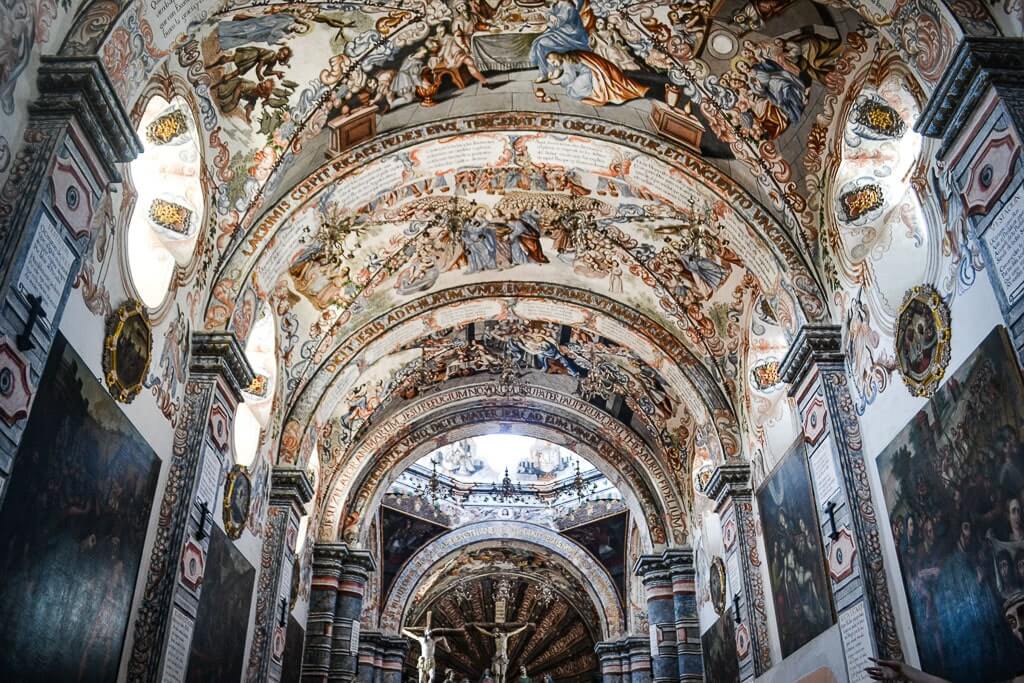
Did you know that Mexico has its very own Sistine Chapel?
Yes, you heard me right.
The Jesuit Sanctuary of Atotonilco, hidden deep in the rural plains of Guanajuato, is fondly called the “Sistine Chapel of Mexico”. That is because of the exuberant murals that adorn its interior.
The Jesuit Sanctuary, along with the historic town of San Miguel de Allende, is a UNESCO World Heritage Site. However, it is often missed by tourists who only explore San Miguel’s historic center but never make it to Atotonilco, only 15 minutes away by car.
The walls and ceiling of the church are covered in colorful frescoes depicting biblical scenes and saints. There are representations of the Last Supper, Jesus’ Ressurection, His Baptism, and several important events from the Bible.
A local artist, Antonio Martinez de Pocasangre, painted the murals singlehandedly over thirty years. As you wander inside, you can almost feel the aesthetic splendor of Michelangelo’s masterpiece in Vatican City.
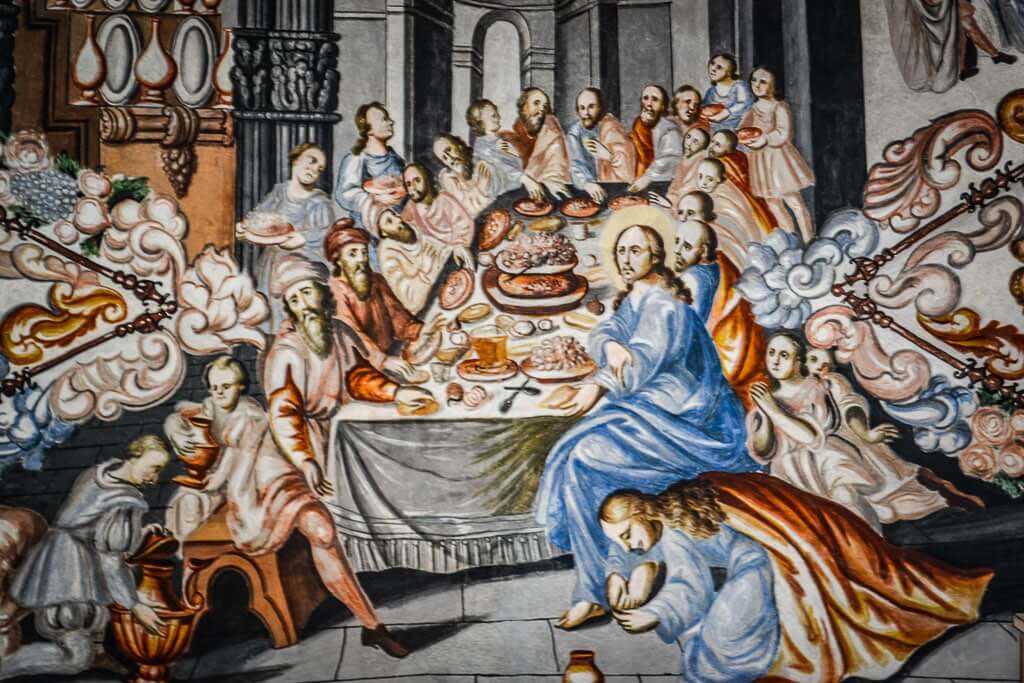
The paintings reflect a beautiful blend of Catholic religious art with native Mexican influences.
Be sure to notice the use of earthy shades such as rust, grey, ochre, and dusty blue which gives the murals a serene, comforting look.
The Sanctuary is also home to the Lord of the Column, a revered image of Christ that draws pilgrims from across Mexico.
The offbeat Sanctuary of Atotonilco, with its fascinating blend of art, history, and spirituality, is absolutely an unmissable part of everyone’s secret Mexico bucket list.
📖 Related Read: Be sure to check out our Travel Guide for the Atotonilco Sanctuary for details on how to get there, what to see, and more travel tips.
Talavera-Adorned Churches of Cholula
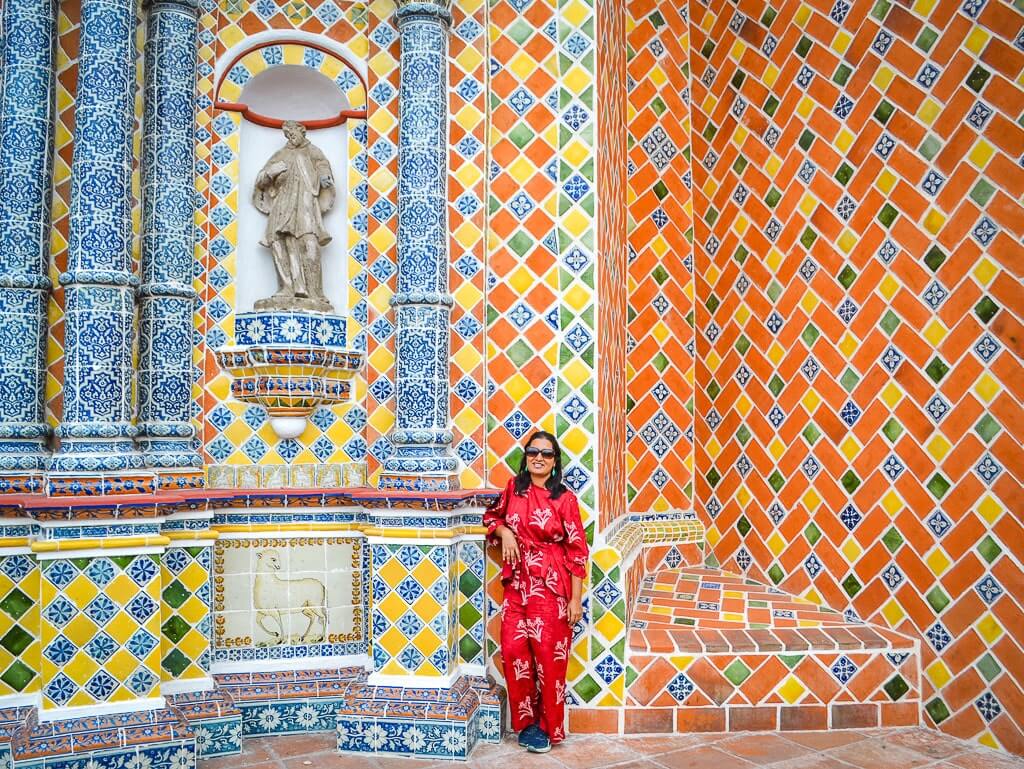
Since we’re talking about Mexican churches, I would not miss this opportunity to talk about the beautiful Talavera-adorned churches of Cholula.
Cholula’s churches are special not only because their facades are covered with the vibrant hues and intricate patterns of Talavera tiles but also because their interiors are decorated with ornate Mexican Baroque carvings.
The Spanish introduced Talavera pottery in Mexico in the 16th century. The artisans of Puebla adopted the art and added their own imagery to it. This gave birth to the distinct Talavera Poblana pottery that is emblematic of the region’s cultural identity today.
There was a time when Talavera factories of Cholula and Puebla produced thousands of tiles, many with small manufacturing defects that ended up on the walls of local churches.
Over time, the tiles created an awe-inspiring spectacle of color, pattern, and texture. Now, the church facades depict myriad motifs, from floral and fauna patterns to geometric designs.
Honestly, these are the prettiest facades I have seen in Mexico. And trust me, I have traveled around the country.
Inside the churches, you’ll find a wealth of religious artwork. Plus, there are ornate Mexican Baroque carvings that represent a harmonious blend of Catholic imagery and indigenous Mexican influences.
📖 Related Read: Visiting Cholula? Then, you’ll definitely want to check our guide on the 13 best things to do in Cholula.
Haciendas of Mexico
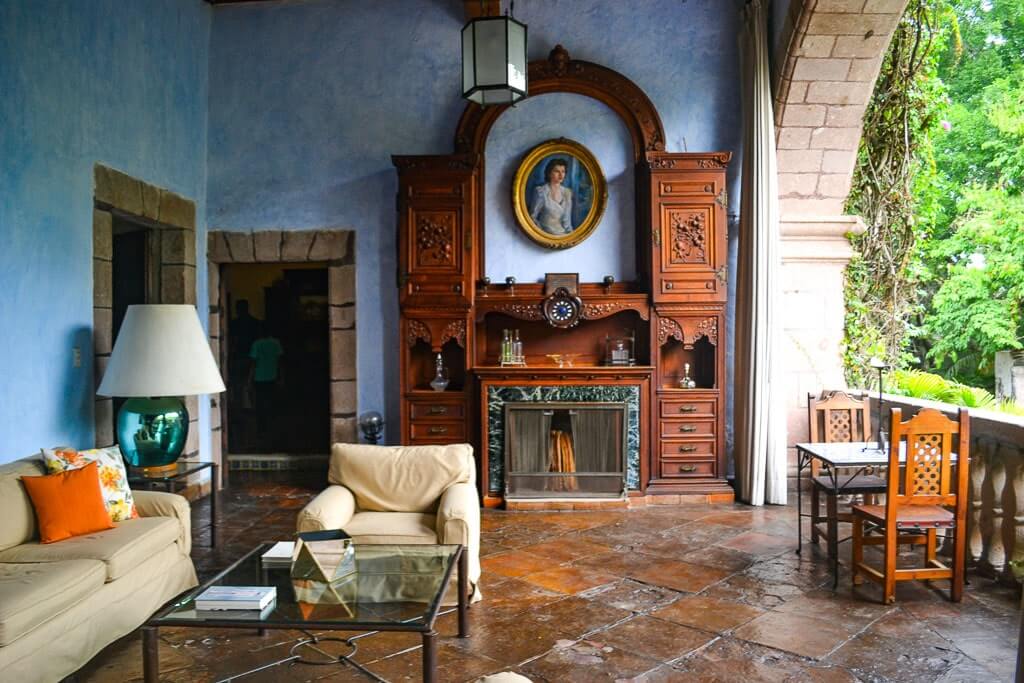
Steeped in history and tradition, the haciendas of Mexico are sprawling plantation estates that offer a fascinating glimpse into Mexico’s colonial past.
The haciendas were the centers of agricultural production during Spanish rule.
Now, many of them have been transformed into boutique hotels, museums, and event spaces. However, they haven’t lost their charm and architectural grandeur in the process.
Visiting a Mexican hacienda or staying in one is almost like stepping back in time.
From the meticulously preserved colonial architecture to the lush, expansive grounds that often include ruins of medieval aqueducts and millhouses, the haciendas have a lot to offer to every history enthusiast.
Additionally, these transformed estates provide an intimate look into the country’s socio-economic history. They highlight the evolution of landholding systems in Mexico and the rise and fall of agricultural monopolies.
I did not realize that haciendas were a vibe in Mexico until I stayed in one.
My 2-day stay at Hacienda San Gabriel de las Palmas was a luxurious affair. A colonial-era room, sprawling grounds full of history, a relaxing pool, and good food made the hacienda a highlight in my Mexico itinerary.
Locals often flock to these restored plantation homes to spend relaxing weekends or attend wedding parties. However, the haciendas still remain Mexico’s best-kept secret for international travelers.
Pyramid of the Niches in El Tajin
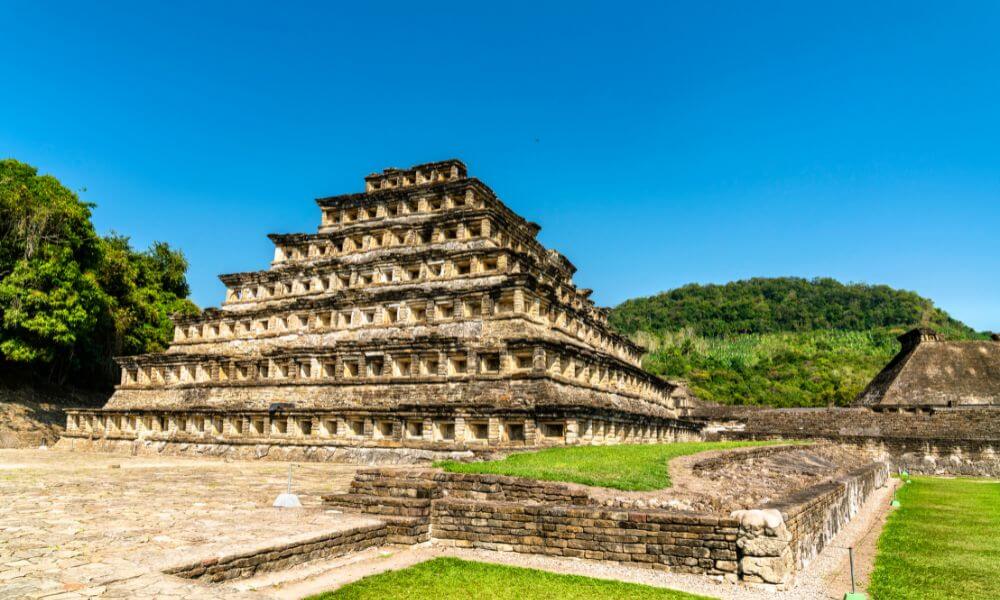
Image courtesy: Leonid Andronov via Canva Pro
If you’re looking for a mysterious Mexican pyramid that’s still untouched by the masses, try the Pyramid of the Niches in the Pre-Hispanic City of El Tajin in the state of Veracruz.
Built by the ancient Totonac people between the 9th and 12th centuries, the El Tajin Pyramid is a unique example of ancient Mesoamerican architecture.
The pyramid looks a little different from what you have seen at Teotihuacan or Chichen Itza. It is 65 feet tall and has 365 recessed niches built into its walls.
Each niche corresponds to a day of the solar year, thus making the pyramid a grand calendar of the Totonac Empire.
Doesn’t that sound familiar? The stairs at Chichen Itza have a similar story to tell.
It is believed that the Totonacs influenced the Mayans a great deal after the fall of Teotihuacan. So, that could explain the similarities.
Beyond the pyramid, the ruins of El Tajin are home to several ball courts, palaces, and plazas. The site is home to 20 ball courts, the most found at any Mesoamerican site.
At Plaza del Arroyo, the oldest set of ruins in El Tajin, you can marvel at four primitive pyramids that were once topped by shrines. Set against the backdrop of lush vegetation, they make a truly remarkable sight.
This UNESCO World Heritage Site is less frequented by tourists and is, therefore, a classic offbeat Mexican gem.
📖 Related Read: Love ancient ruins and pyramids? Check out our guide for the 20 fascinating pyramids to visit in Mexico.
Archeological Site of Xochicalco
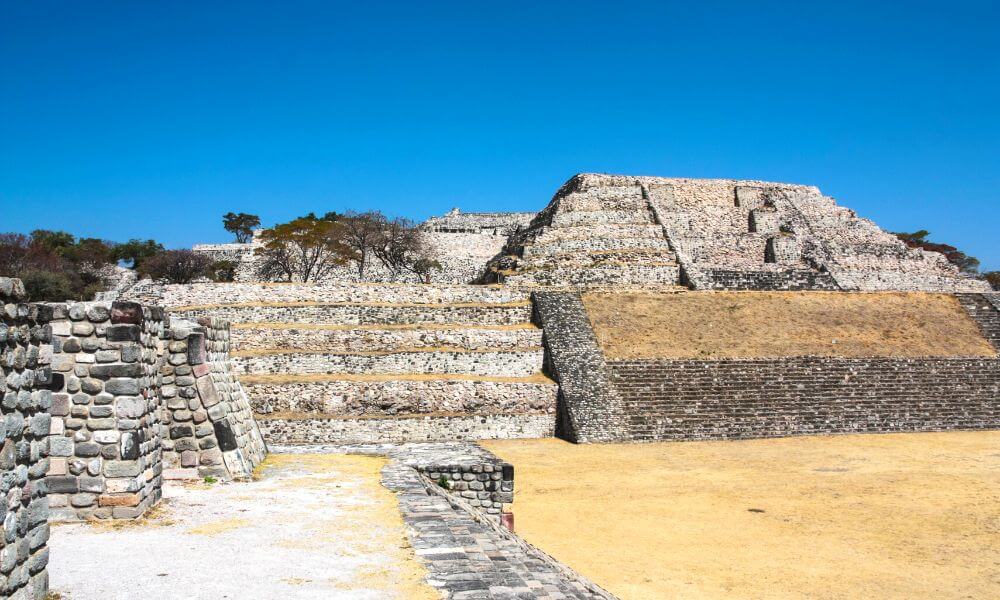
Image courtesy: steve_is_on_holiday from Getty Images Signature via Canva Pro
The Archeological Site of Xochicalco is a UNESCO World Heritage Site that’s also one of the most offbeat historic destinations in Mexico.
Xochicalco was an important political and ceremonial center in pre-Hispanic Mexico. It rose to its zenith in the 7th and 8th centuries after the fall of Teotihuacan.
This period was a time of great change and dissent in ancient Mesoamerica. Xochicalco rose to power by constructing the first fortified town in pre-Columbian Mexico.
The ruins of Xochicalco are on the top of a series of low-lying hills in the Mexican State of Morelos.
However, this wasn’t done to enjoy the panoramic views of the countryside. The intention was to provide Xochicalco the strategic advantage of height so that the city could always keep a check on approaching enemies.
Today, Xochicalco is a lesser-known historic city with intricate architectural designs and stone carvings.
The Temple of the Feathered Serpent is one of its most remarkable structures. The temple is embellished with detailed reliefs of feathered serpents that also shows cultural exchange between different Mesoamerican societies including the Mayans and the Teotihuacanos.
Additionally, Xochicalco is home to a remarkably well-preserved ancient observatory. This astronomical observatory was designed to capture the light of the setting sun during the solstices.
Earliest 16th-Century Monasteries on the Slopes of Popocatepetl
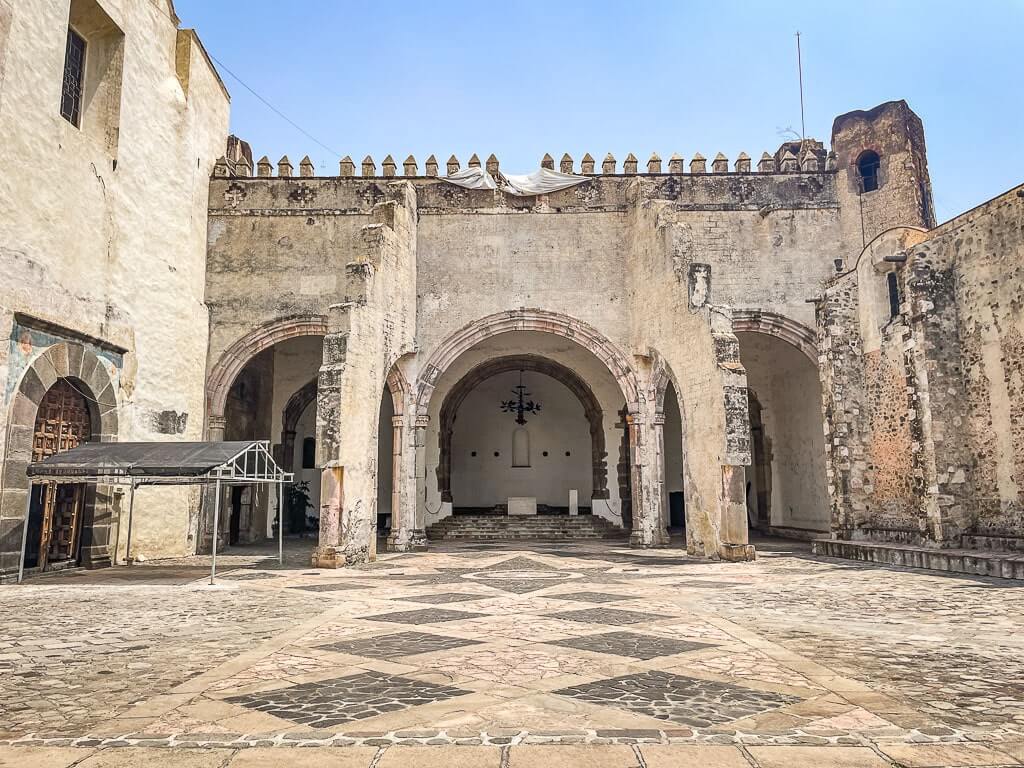
The 16th-century monasteries on the slopes of Popocatepetl are a unique collection of 15 colonial churches built by the first missionaries.
These churches are spread over the states of Puebla, Morelos, and Tlaxcla. The Spanish missionaries built them in the early 16th century to evangelize the native population.
Since large-scale conversions were the norm then, the monasteries included novel architectural elements to accommodate a large masses.
Open chapels (cappila abierta) and posa chapels (capilla posa) became common.
Further, the location of these monasteries on the slopes of Popocatepetl, an active volcano, added to their mystical aura. Not to mention, these sanctuaries were often seen as a blend of natural beauty and architectural grandeur.
The journey to these monasteries takes you through quaint Mexican villages and enchanting landscapes, an experience that is as rewarding as the destination itself.
Recently, I had the opportunity to visit the Cathedral in Cuernavaca. The church complex oozed a different aura with a fortress like structure and several auxiliary posa chapels. The Open Chapel stood as a reminder of colonial power and religious submission.
The Great Pyramid of Cholula
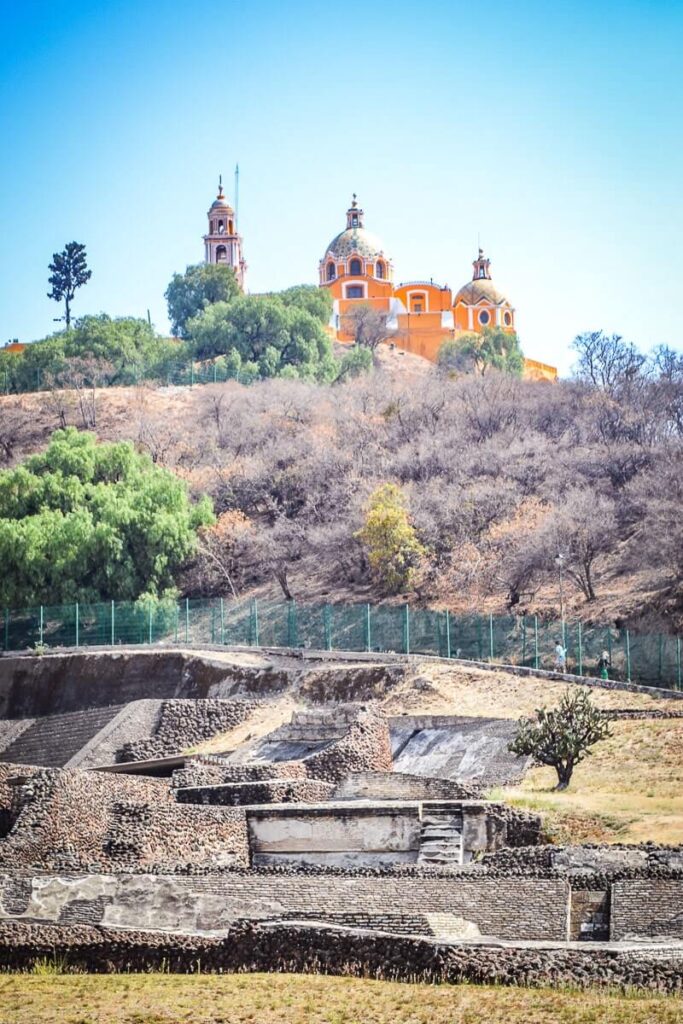
Despite being the largest pyramid (by volume) in the world, the Great Pyramid of Cholula remains one of Mexico’s best hidden gems. This is primarily due to the fact that it is largely covered with vegetation giving it the appearance of a hill.
This subtlety is likely the reason why many people don’t know of the size and grandeur of the Great Pyramid of Cholula.
Therefore, it is often overlooked by tourists, who flock instead to the more visually striking and well-known pyramids of Teotihuacan and Chichen Itza.
Cholula’s Great Pyramid dates to the 3rd century BCE. It was built in several stages and has a volume of 4.5 million cubic meters, the largest of any single structure in the world.
Beneath the towering facade of the pyramid lies an intricate network of tunnels that gives astonishing insights into the life and culture of ancient Mexico. Sadly, the tunnels are closed to visitors since COVID struck but I’m hoping they’ll open soon.
On the top of the hilly pyramid stands the vibrant yellow Church of Our Lady of Remedies which was built right after the Spanish conquest. You can climb up to the church for panoramic views of the city.
Mexico hides the most voluminous pyramid in the world. Yet, the pyramid remains Mexico’s best kept secret!
✦ Pro Tip: The Great Pyramid of Cholula is an easy day trip from Puebla. Check this highly-rated private tour of Cholula that allows you to see the pyramid and the Talavera-adorned churches.
Pre-Hispanic City of Palenque
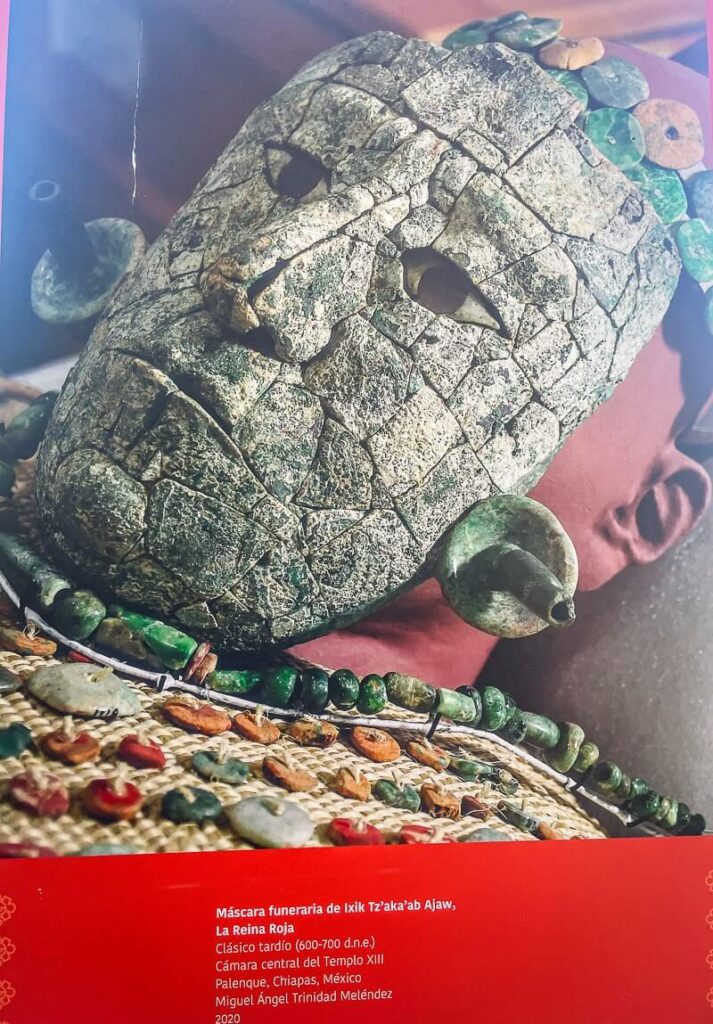
Located in the southern Mexican state of Chiapas, the Pre-Hispanic City of Palenque is one of Mexico’s best kept secrets.
Despite its smaller size compared to other prominent Mayan cities, Palenque packs a punch with its historically significant ruins. Its location in the middle of a lush tropical jungle only adds to the appeal.
The archaeological site of Palenque is rare due to its well-preserved sculptures and sculpted reliefs that provide deep insights into Mayan culture and mythology.
The site’s centerpiece, the Temple of Inscriptions, is known for its remarkable hieroglyphic inscriptions. These are the longest texts to be discovered in the Mayan world till date.
Inside this temple, archeologists also discovered the jade-covered sarcophagus of Pakal the Great, a powerful Mayan ruler.
Visitors to Palenque can marvel at the splendid ruins that emerge from the foggy foliage, explore the palace with its distinctive tower, and stroll through the courtyards echoing the tales of a bygone era.
In addition to the archaeological treasures, Palenque’s location allows you to experience Mexico’s vibrant biodiversity.
From howler monkeys swinging in the trees to tropical birds singing melodies, the ancient city is a perfect haven for history and nature lovers.
✦ Pro Tip: The best way to visit Palenque is on this full-day, private tour that allows you to learn all about this ancient civilization.
Puuc Route in Yucatan
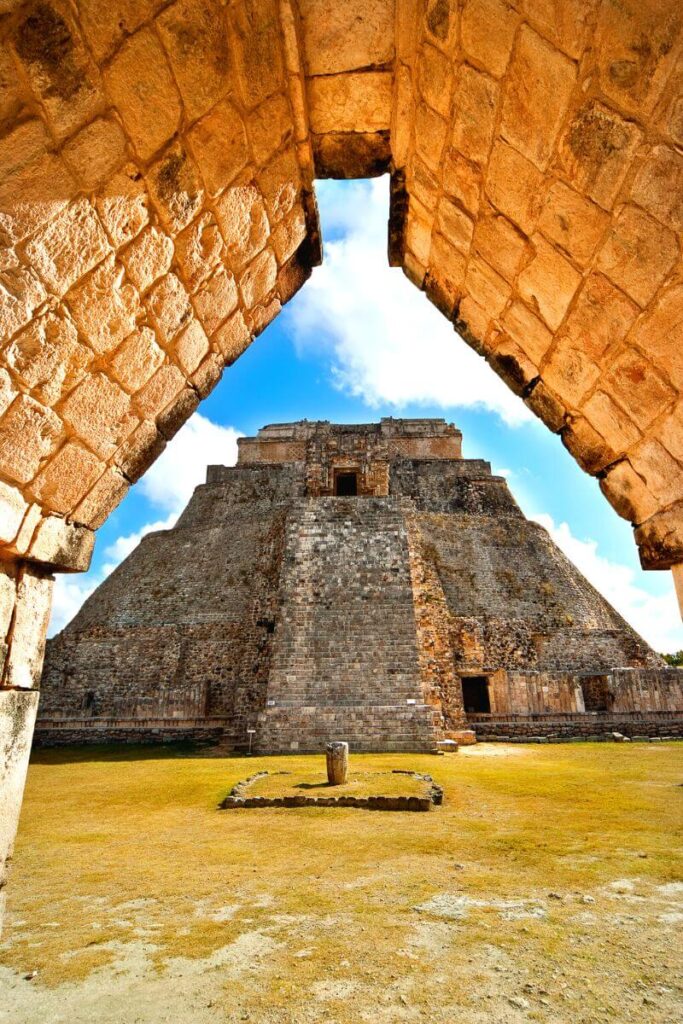
Image courtesy: SerrafinoMozzo from Getty Images via Canva Pro.
The Puuc Route in the Yucatan Peninsula is an exciting journey into Mexico’s Mayan past. It provides insights into a special architectural style of the Mayan civilization that is often overlooked by mainstream tourists.
The term ‘Puuc’ refers to a hilly region in Yucatan. “Ruta Puuc” or the Puuc Route refers to a trail of remarkable archaeological sites of Uxmal, Kabah, Sayil, Xlapak, and Labna.
The Puuc style of architecture is distinctive. It is characterized by smooth wall surfaces finished with limestone plaster and ornate stucco carvings. The Puuc style flourished between the 7th – 10th centuries.
Uxmal is the most well known Mayan ruin in Puuc Style. The impressive Governor’s Palace and the Magician’s Pyramid are exemplary of Puuc architecture.
Several other Puuc ruins are Mexico’s secrets hidden deep in the jungles of Yucatan.
Kabah is famous for its ‘Palace of Masks’, a structure adorned by hundreds of stone masks depicting the rain god Chaac.
Sayil and Xlapak, though less grand, captivate with their exquisitely carved facades and serene ambiance. Labna is known for its elaborately designed arch.
Visitors find the Puuc Route fascinating because it gives them a unique opportunity to appreciate the evolution of Mayan architecture and civilization. The route also offers a chance to explore the Yucatan’s breathtaking natural landscapes and endemic wildlife.
Loved our Mexico Hidden Gems guide? Pin it for later!
